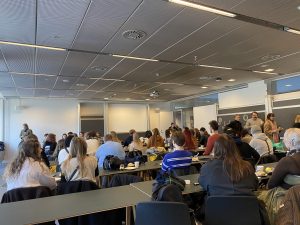Every year in autumn, a large and popular festival is celebrated in India and around the globe in places that have become home to Hindu migrant communities – also in Helsinki. As this festival, Durgāpūjā, has extensively traveled with Indian communities, beyond many geographical and cultural borders, it is a perfect example to study and experience how festivals are important events for diasporic communities to live, stage and negotiate identity, heritage and culture – beyond borders (Zeiler 2022). The festival was added to UNESCO’s intangible cultural heritage list in 2021.
Helsinki annually hosts two or three such events, as “Nowadays the capital region (Helsinki, Espoo, Vantaa) witnesses three Durga Puja, organized by different groups” (Moon Ray 2023). These include the oldest and largest event by Helsinki’s Bengali Association of Finland Ry – BAF (formerly Finben), the Sri Sri Sarbojanin Durga Puja Pujari Association in Vantaa since 2010, and Sharodiya Durga Puja Mohamaya that has been organizing events in Helsinki’s Kivikko area since 2016 (Moon Ray 2023). Additionally – as Helsinki has become home to Indians with their family origins in many of the Indian states that traditionally have different forms of celebrating the “Nine nights of the goddess” festival (e.g., Simmons, Sen and Rodrigues 2010) – the Metropolitan Area sees more than these activities related to the celebrations. One of the main reasons for hosting the festival is to come together in the communities and to jointly celebrate.

Invitation on Helsinki’s Bengali Association of Finland Ry’s Facebook page, October 2023.
One of the themes that are declaredly important to festival visitors, even more so in a diaspora setting, is education. In preparation of the celebration days, traditionally a cultural program is arranged and practiced. This is seen by many persons whom I spoke to as a good space to include education about what
was often termed the own cultural heritage. In this way, the character of not only the cultural program but the entire festive get-together have a very intensive community focus – with a strong element of cultural education. In summary, Durgāpūjā presents an opportunity to jointly showcase and enjoy what is perceived as own cultural heritage, and a highly important space to publicly and jointly educate the community’s kids about it – for example, in kids performances, drawing competitions, recitals and so on. As such, diaspora festival related networking (in and beyond social media) extends to the important questions of trans-generational education.
Research on this is ongoing at UH and new collaborations are planned, with different diasporic communities and educational institutions around the globe – for instance, based on these observations and on initial studies with the Helsinki Bengali community, I recently presented a conference paper on Trans-Generational Education in Indian Diasporic Festivals: Networking in and beyond Social Media as Diasporic Communication, at the American Academy of Religion conference in the US, funded by the Finnish education network GINTL India. GINTL is a network in which Finnish higher education institutions (including UH), together with partners from India, China and Africa, co-create research-based solutions to global educational challenges and collaborate in research and education.
If you are interested, stay tuned for a follow-up blog entry soon, keeping you in the loop about the already existing and new upcoming educational initiatives at UH, related to Durgāpūjā – in Helsinki and beyond! Just one of the new outcomes is the educational video game Durga Puja Beyond Borders that introduces various layers of Durga Puja festival culture, such as joint Durga Puja organizations and especially celebrations, in Helsinki. It conveys educational content about the festival’s history and past and present ways of worshipping and jointly celebrating, in India and beyond.

To access the game trailer pls click: https://www.youtube.com/embed/t4C2kNkSusw?feature=oembed
Trailer for the educational game Durga Puja Beyond Borders, a collaborative effort of the University of Helsinki (Finland), Xenia Zeiler, and the Kolkata (India) based award-winning game development studio Flying Robot Studios, Satyajit Chakraborty. Enjoy playing!
Xenia Zeiler
References:
Moon Ray (2023). “Durga Puja in Helsinki, Espoo, Vatnaa – Finland”. Available at https://www.nomadicmun.com/durga-puja-in-finland/, accessed 5 December 2023.
Simmons, Caleb, Sen, Moumita and Rodrigues, Hillary, eds. (2018). Nine Nights of the Goddess. The Navaratri Festival in South Asia. New York, State University of New York Press.
UNESCO (2021). Durga Puja inscribed on the UNESCO Representative List of the Intangible Cultural Heritage of Humanity. Press release. Available at https://www.unesco.org/en/articles/durga-puja-inscribed-unesco-representative-list-intangible-cultural-heritage-humanity, accessed 5 December 2023.
Wessman, Anna, Zeiler, Xenia, Thomas, Suzanne and Vainonen, Pilvi. (2020). “The Durga Puja pop-up exhibition at the National Museum of Finland: Studying, Designing and Hosting an Exhibition as University Education-Museum Collaboration”. Nordisk museologi, 29(2): 96-105. https://doi.org/10.5617/nm.8445.
Zeiler, Xenia and Chakraborti, Satyajit (2021). Durga Puja Beyond Borders: An Educational Video Game about Global Indian Festival Cultures. Available at https://blogs.helsinki.fi/durgapuja-the-videogame/new-durga-puja-beyond-borders/, accessed 5 December 2023.
Zeiler, Xenia (2022). Festivals on the move: Cultural heritage, Indian migrant communities and Durgāpūjā in Helsinki. Heritage on the Move (Blog of the UNA Europa transnational research team “Heritage, Global Migration and Mobility”). Available at https://herblog.hypotheses.org/139, accessed 5 December 2023.



 game icon, The Durga Puja Mystery
game icon, The Durga Puja Mystery